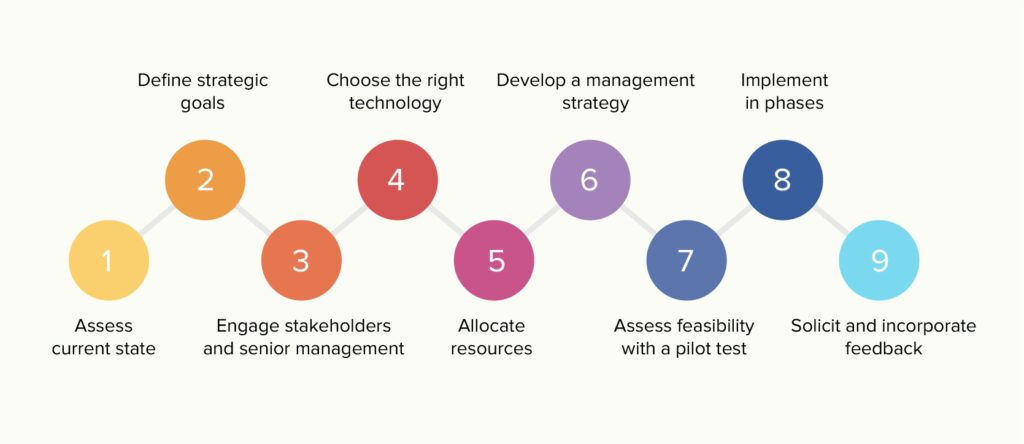Did you know that although 89% of large companies globally have a digital and AI transformation underway, they have only captured 31% of the expected revenue lift and 25% of expected cost savings from the effort?
Digital transformation is no longer optional; it’s necessary for businesses striving to remain competitive in today’s highly-accelerated, tech-savvy world. As customer expectations evolve, new technologies emerge, and markets grow increasingly dynamic, a robust digital transformation strategy ensures businesses can adapt, thrive, and innovate. A well-structured strategy provides a clear roadmap to guide an organization from its current state to its envisioned future state, enabling it to leverage modern technologies effectively.
However, many organizations embark on their digital transformation journey without enough planning, resulting in wasted resources, misaligned objectives, and failed initiatives. Companies can maximize their return on investment (ROI) and ensure long-term success by creating a strategy that aligns with business goals and mitigates potential risks.
The challenge lies not in recognizing the need for digital transformation but in developing and executing a coherent strategy that delivers real business value. As organizations invest heavily in digital initiatives – with worldwide spending on digital transformation expected to reach $3.4 trillion by 2026 according to IDC's latest forecast – the importance of a structured approach becomes paramount.
In this article, we are going to map out how to build your digital transformation strategy, giving you key pointers and best practices to realize the true and maximum potential that digital transformation holds for your organization.
Key Components of a Digital Transformation Strategy
Building a successful digital transformation strategy requires a comprehensive understanding of your organization’s unique needs and capabilities. The following components form the foundation of an effective strategy:
1. Vision and Objectives
Your digital transformation journey should start with a clear vision. What does your business aim to achieve? Is the goal to enhance customer experiences, streamline operations, or drive innovation? For example, a retail company might focus on creating seamless omnichannel shopping experiences, while a manufacturing firm could prioritize automating production processes.
A successful digital transformation strategy begins with a clear vision that aligns with your organization's overall business objectives. According to Deloitte's 2025 Tech Trends report, organizations that explicitly link their digital initiatives to business strategy are 2.5 times more likely to be successful in their transformation efforts.
Key elements of a strategic vision include:
- Clearly defined business outcomes
- Timeline for achievement
- Resource requirements
- Success metrics
Defining these objectives ensures that all departments and stakeholders work towards the same goals, avoiding fragmentation and misaligned priorities. Businesses can track progress and refine their strategies over time by setting measurable targets, such as increasing operational efficiency by 25% or reducing customer churn by 15%.
2. Current Technology Ecosystem
Before moving forward, it’s essential to understand your starting point. Conduct a thorough audit of your current IT infrastructure, systems, and processes. Identify outdated technologies that may hinder progress and evaluate the integration capabilities of existing systems.
For example, legacy systems might struggle to handle modern cloud-based solutions or advanced analytics tools. Mapping out your technology ecosystem not only highlights areas needing improvement but also ensures that new technologies align with existing ones, minimizing disruptions.
Before embarking on any transformation initiative, organizations must thoroughly understand their current technology landscape. This involves:
- Infrastructure inventory
- Application portfolio review
- Data architecture assessment
- Integration capabilities
- Security posture
The MIT Sloan Management Review's 2024 Digital Transformation Study reveals that organizations that conduct thorough technology assessments are 45% more likely to achieve their transformation goals.
3. Current and Future Needs
Digital transformation is not a one-time initiative but a forward-looking strategy. Consider both current pain points and future growth needs. For instance, does your organization require advanced data analytics capabilities to drive decision-making? Will you need scalable cloud infrastructure to support anticipated growth?
Forward-thinking organizations also anticipate industry trends, such as shifts toward automation, sustainability, or customer personalization. Staying ahead of these trends ensures that your investments are sustainable and adaptive to evolving business conditions. Leveraging market trend analyses, industry forecasts, and competitor benchmarking can guide these considerations, ensuring the organization remains proactive rather than reactive.
To bridge the gap between current capabilities and future requirements, organizations should:
- Identify business-critical processes requiring digital enhancement
- Assess technology gaps impeding business growth
- Evaluate emerging technologies relevant to business objectives
- Prioritize initiatives based on business impact and feasibility
4. Risk Identification and Mitigation
Every digital transformation initiative comes with risks, such as data security breaches, operational disruptions, and employee resistance. A comprehensive risk assessment framework should identify potential challenges and develop mitigation strategies. For example, ensuring robust cybersecurity measures and compliance with regulations like GDPR or CCPA can reduce risks related to data privacy.
Moreover, organizations should consider creating contingency plans for unexpected disruptions, such as system outages or vendor failures. Proactively addressing these risks not only minimizes setbacks but also builds trust with stakeholders who expect smooth transitions.
Gartner's 2024 Emerging Risk Report highlights that successful digital transformations incorporate comprehensive risk management. Key areas to address include:
- Cybersecurity risks
- Data privacy compliance
- Change management challenges
- Resource allocation risks
- Technology integration risks
How to Build a Digital Transformation Roadmap
A roadmap acts as a bridge between your current state and your digital transformation goals. It provides a step-by-step plan to achieve desired outcomes while keeping all stakeholders aligned.

Step 1: Audit Your Current State
Start by conducting a detailed review of your organization’s existing processes, workflows, and technologies. Identify inefficiencies, redundancies, and gaps that digital transformation can address. For example, an audit might reveal that manual invoicing processes are causing delays, which automation could solve.
Audits should also include stakeholder interviews, surveys, and data analytics to uncover bottlenecks or hidden inefficiencies. Tools like process mining software can help visualize workflows and highlight improvement areas. Documenting these findings creates a baseline for measuring progress.
A thorough understanding of your organization's digital maturity is the foundation of any successful digital transformation. Harvard Business Review's 2024 Digital Transformation Report indicates that companies conducting comprehensive assessments are 3x more likely to achieve transformation success.
Step 2: Set SMART Goals
Specific, Measurable, Achievable, Relevant, and Time-bound (SMART) goals provide clarity and focus. For instance, instead of setting a vague goal like “improve customer satisfaction,” aim to “increase Net Promoter Score (NPS) by 10 points within 12 months.” SMART goals make it easier to track progress and demonstrate success.
Additionally, linking these goals to financial metrics, such as revenue growth or cost savings, ensures alignment with broader business objectives. Communicating these goals to all team members fosters accountability and engagement.
Step 3: Engage Stakeholders
Involve key stakeholders from the beginning, including leadership teams, IT departments, and end-users. Their input ensures that the strategy addresses diverse perspectives and needs. Engaging stakeholders early also builds buy-in and reduces resistance to change, which is critical for successful implementation.
Stakeholders should not only include internal teams but also external partners, such as vendors or consultants, who play crucial roles in delivering transformation projects. Regularly scheduled updates and feedback sessions keep everyone aligned throughout the process.
Step 4: Prioritize Initiatives
Not all initiatives can or should be tackled at once. Use a prioritization matrix to rank projects based on factors like impact, feasibility, and alignment with business objectives. Starting with quick wins—such as automating repetitive tasks—can build momentum and demonstrate value early on.
Balancing short-term wins with long-term strategic initiatives ensures sustained progress without overwhelming teams or depleting resources. Periodically revisiting priorities allows adjustments as new opportunities or challenges arise.
Step 5: Allocate Budget and Resources
Allocate financial and human resources effectively. Ensure that budgets account for technology investments, training programs, and ongoing support. Transparent budgeting processes help avoid unexpected costs and ensure that projects remain financially viable.
Organizations should also consider setting aside contingency funds to address unforeseen expenses or delays. Tracking spending against budgets through project management tools ensures accountability and real-time adjustments.
Step 6: Choose the Right Technologies
Selecting the right technologies is critical to the success of your digital transformation strategy. Consider scalable, flexible solutions like cloud computing platforms, AI-driven analytics tools, and IoT devices. Evaluate vendors using trusted resources like G2 or Forrester Wave to ensure they meet your needs.
Pilot-testing new technologies before full implementation helps identify potential issues early. Additionally, working with managed service providers (MSPs) can streamline deployment and ongoing maintenance, ensuring optimal performance.
Post-Implementation: Measuring Progress and Ensuring Success
After implementing your digital transformation initiatives, measuring their impact and making necessary adjustments is essential. Continuous monitoring and improvement are key to sustaining success.
1. Measure Progress
Define key performance indicators (KPIs) that align with your objectives, such as revenue growth, operational efficiency, or customer retention rates. For example, if the goal is to reduce customer wait times, measure the average response time before and after implementation. Real-time dashboards can provide visibility into these metrics, allowing for timely interventions.
Organizations should conduct quarterly or biannual reviews to assess progress and address challenges. Sharing these results with stakeholders reinforces transparency and accountability.
2. Calculate ROI
Quantify the financial benefits of your initiatives by comparing cost savings, revenue increases, and productivity gains against the initial investment. Tools like ROI calculators tailored to digital transformation projects can simplify this process.
Showcasing ROI through detailed reports justifies the investment and builds momentum for future transformation efforts.
3. Continuously Mitigate Risks
Digital transformation is ongoing, and new risks may emerge over time. Regular audits and updates to your risk management framework can help address potential vulnerabilities, such as evolving cybersecurity threats or compliance requirements.
Creating dedicated task forces for risk assessment ensures proactive responses to emerging challenges. Training employees on cybersecurity best practices also enhances organizational resilience.
4. Encourage Continuous Learning
Invest in training programs to ensure employees can use new tools and technologies effectively. Encourage a culture of innovation by rewarding experimentation and welcoming feedback. This boosts adoption rates and fosters a sense of ownership among team members.
Partnering with educational platforms or certifying employees in relevant technologies demonstrates a commitment to professional development while equipping teams with cutting-edge skills.
| Industry | Company | Transformation Initiative | Best Practices | Impact |
| Retail | Walmart | AI-driven inventory management and predictive analytics | - Leverage AI for real-time inventory insights. - Integrate in-store and online channels seamlessly. | - Reduced stockouts by 20%. - Improved customer satisfaction and loyalty metrics. |
| Healthcare | Cleveland Clinic | IoT and predictive analytics for patient care | - Use IoT devices for real-time monitoring. - Prioritize data security and patient confidentiality | - Enhanced patient outcomes with 24/7 monitoring. - Reduced hospital readmissions. |
| Manufacturing | General Electric | Predictive maintenance using IoT sensors | - Start with pilot projects before scaling. - Automate data collection and analysis for efficiency. | - Minimized equipment downtime by 30%. - Extended machinery lifecycle significantly. |
| Financial services | JPMorgan Chase&Co | AI for fraud detection and personalized financial services | - Invest in advanced analytics for decision-making. - Personalize services using customer data insights. | - Reduced fraud losses by 25%. - Increased customer retention through tailored services. |
| Education | Khan Academy | AI-powered personalized learning paths | - Use adaptive learning algorithms to customize content. - Focus on accessibility for diverse audiences. | - Improved learning outcomes for students worldwide. - Expanded reach to underserved areas. |
| Transportation | Uber | Dynamic pricing algorithms and AI-driven routing | - Implement real-time data analysis for pricing. - Use AI to optimize routes and reduce delays. | - Reduced wait times by 15%. - Increased driver and passenger satisfaction. |
| Hospitality | Marriott | Mobile check-ins and AI-enhanced guest experiences | - Adopt mobile-first strategies. - Leverage AI for hyper-personalized customer service. | - Increased guest satisfaction by 18%. - Boosted repeat bookings significantly. |
Wrapping up
It may sound cheesy but it’s nonetheless the truth: digital transformation is a journey, not a destination.
A structured strategy helps businesses align their goals, reduce risks, and maximize ROI. Whether starting from scratch or refining existing initiatives, taking the first step is crucial. Begin with an internal audit or consult digital transformation experts who can guide your journey.
By focusing on clear objectives, engaging stakeholders, and leveraging the right technologies, your organization can unlock new opportunities and drive sustained growth in an increasingly competitive landscape.
Contact us and let’s embark on this exciting project together.



![[Blog cover] SEO optimization best practices](https://svitla.com/wp-content/uploads/2025/05/Blog-cover-SEO-optimization-best-practices-560x310.jpg)
